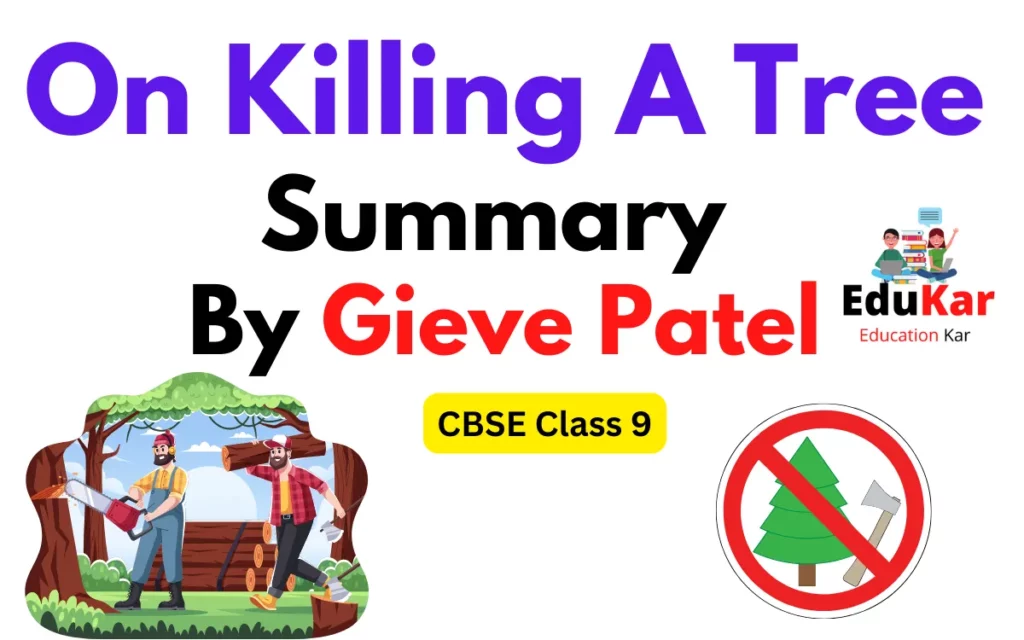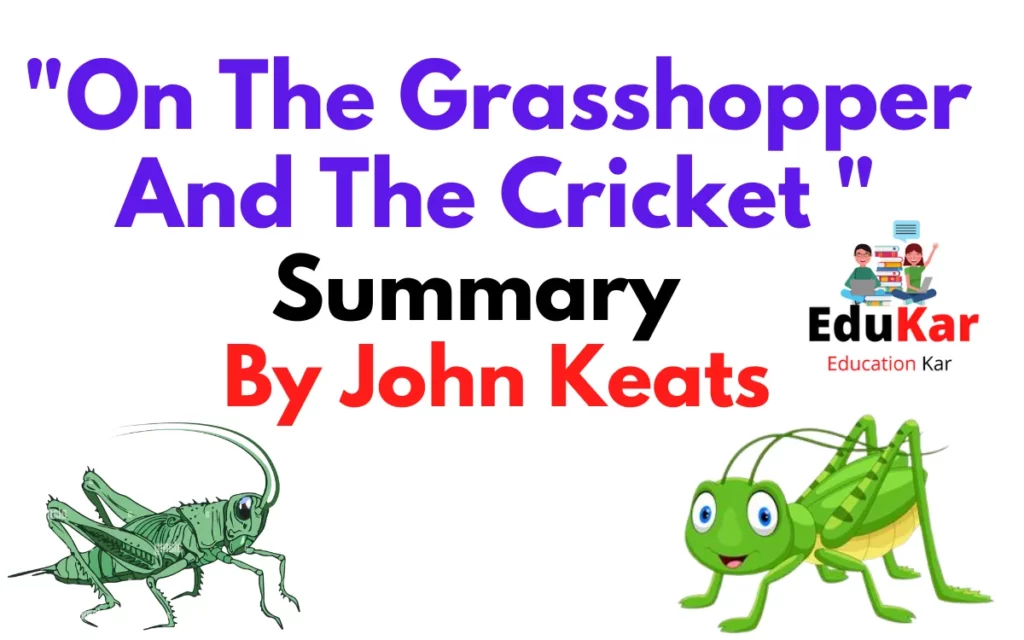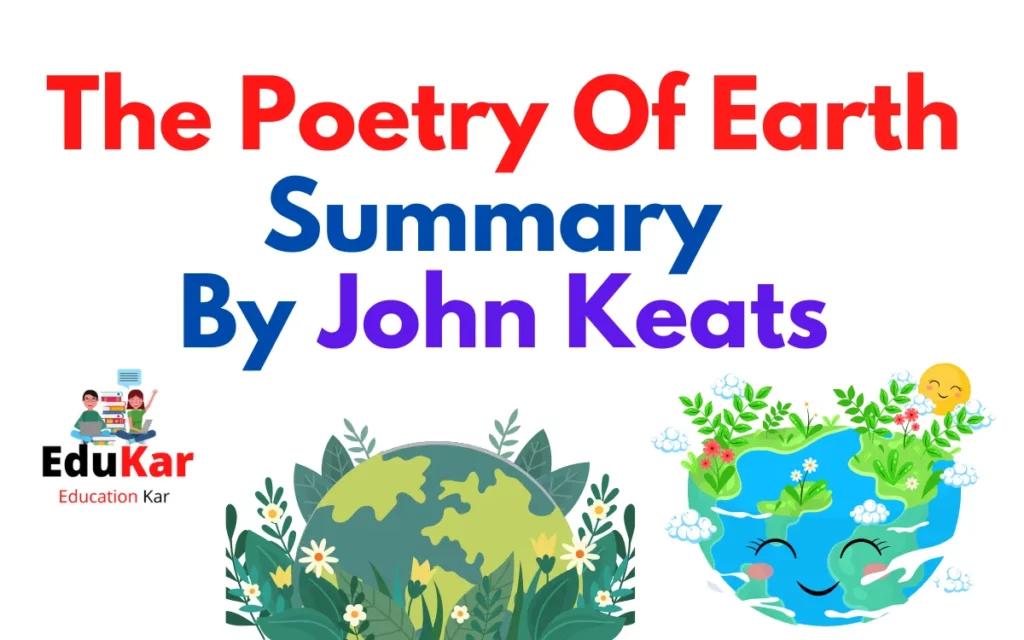| Name | On Killing A Tree |
|---|---|
| Subject | English |
| Class | 9 |
| Board | CBSE |
| Type | Poem |
| Author | Gieve Patel |

Introduction
“On Killing a Tree” is a poem written by Indian poet and playwright Gieve Patel. The poem reflects on the destructive nature of human beings and the consequences of their actions. It describes the process of cutting down a tree and portrays it as a violent and destructive act. The poem also reflects on the consequences of this act, such as the fading leaves, withering branches and how the death of the tree will affect the animals and insects that lived in it. Additionally, the poem shifts to a more general reflection on the destructive nature of human beings, how they are responsible for the destruction of the natural world, and how their actions have led to the extinction of many species. The poem serves as a powerful reminder of the importance of preserving the natural world and the need to be mindful of our impact on the environment.
English Summary – “On Killing A Tree”
“On Killing a Tree” is a poem written by Indian poet and playwright Gieve Patel. The poem reflects on the destructive nature of human beings and the consequences of their actions.
The poem begins by describing the process of cutting down a tree, which is portrayed as a violent and destructive act. The tree is described as being alive and full of vitality, with roots that run deep into the earth. The speaker describes the process of cutting down the tree as a “murder” and a “slaughter.”
As the tree falls, the speaker reflects on the consequences of this act. The tree’s leaves are described as “fading” and its branches as “withering.” The speaker also describes how the tree’s death will affect the animals that lived in it and the insects that fed on it.
The poem then shifts to a more general reflection on the destructive nature of human beings. The speaker describes how humans are responsible for the destruction of the natural world, and how their actions have led to the extinction of many species. The speaker also reflects on how humans are destroying the earth and how their actions will have dire consequences for future generations.
In the end, the poem is a reflection on the destructive nature of human beings and the consequences of their actions. It serves as a powerful reminder of the importance of preserving the natural world and the need to be mindful of our impact on the environment. It also serves as a call to action for people to take responsibility for their actions and to work towards a more sustainable future.
Overall, Gieve Patel’s poem is a powerful reflection on the destructive nature of human beings and the consequences of their actions. It is a call to action for people to take responsibility for their impact on the environment and to work towards a more sustainable future. The poem can be a reminder that the world is not just for us, but also for the future generations and the other living things that share the planet with us.
About The Author
Gieve Patel is an Indian poet and playwright. He was born in Bombay (now Mumbai), India, in 1940. He studied medicine at Grant Medical College in Mumbai and later worked as a general practitioner before turning to writing full-time. He is known for his poetry and plays that reflect on social and political issues, as well as the human condition. Patel’s poetry often explores the lives of the working-class, and he has also written plays that address issues such as poverty, caste discrimination, and political violence.
Conclusion – “On Killing A Tree”
In conclusion, “On Killing a Tree” is a powerful and thought-provoking poem written by Indian poet and playwright Gieve Patel. The poem reflects on the destructive nature of human beings and the consequences of their actions. The poem begins by describing the process of cutting down a tree, which is portrayed as a violent and destructive act, and then reflects on the consequences of this act, such as the fading leaves, withering branches, and how the death of the tree will affect the animals and insects that lived in it. Additionally, the poem shifts to a more general reflection on the destructive nature of human beings, how they are responsible for the destruction of the natural world, and how their actions have led to the extinction of many species. The poem serves as a powerful reminder of the importance of preserving the natural world and the need to be mindful of our impact on the environment. It is a call to action for people to take responsibility for their impact on the environment and to work towards a more sustainable future.
FAQs
What is “On Killing a Tree” about?
“On Killing a Tree” is a poem that reflects on the process of destroying a tree, both physically and metaphorically. The poet describes the gradual process of cutting down a tree and the emotions associated with it, ultimately describing it as a violent act.
What is the theme of the poem?
The theme of the poem is the violence and destruction of nature, and the emotions that come with it.
What is the style of the poem?
The poem is written in free verse with a conversational tone, using vivid imagery to describe the process of cutting down a tree.
How does the poem relate to the environment?
The poem highlights the destructive nature of human actions towards the environment, specifically focusing on the act of cutting down a tree and the consequences of it. It also reflects on the emotional impact of destroying nature on human.
How does the poem make the reader feel?
The poem evokes a range of emotions in the reader, including sadness, guilt, and empathy. It encourages readers to reflect on their own actions and the impact they have on the environment.


![Grandma Climbs A Tree Summary [Class 10] By Ruskin Bond Grandma Climbs A Tree Summary](https://edukar.in/wp-content/uploads/2022/09/Grandma-Climbs-A-Tree-Summary-1024x597.webp)


![Natural Vegetation and Wildlife Class 9 Questions Answers [Class 9 Geography Chapter 5] Natural Vegetation and Wildlife Questions Answers](https://edukar.in/wp-content/uploads/2023/01/Natural-Vegetation-and-Wildlife-Questions-Answers--1024x640.webp)








![Digital Documentation Class 9 [Questions Answers & MCQ] Digital Documentation Class 9](https://edukar.in/wp-content/uploads/2022/08/Digital-Documentation-Class-9-1024x597.webp)
![Packing Class 9 Questions and Answers [Class 9 English Beehive Chapter 7 ] Packing Class 9 Questions and Answers [Class 9 English Beehive Chapter 7 ]](https://edukar.in/wp-content/uploads/2023/01/Packing-Class-9-Questions-and-Answers-1024x640.webp)
